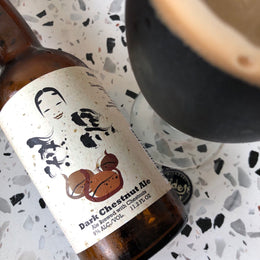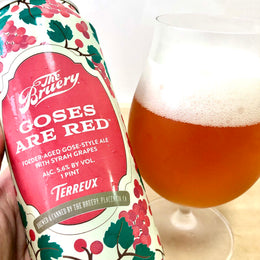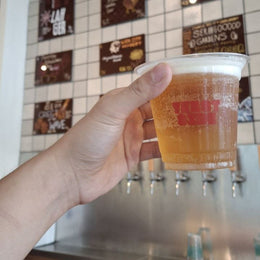
Is that not a rather evocative label? We'll get to that in abit. Although I will say that in all the times I've shared this, the overwhelming response has been "Oh my god! Cantillon!", with pretty much no recollection from anyone on what the label was.
In any case, we've got to talk about Cantillon, arguably one of the greatest Lambic producers today.


Probably not as large as you might've thought given the brewery's outsized reputation.
The Brasserie Brouwerij Cantillon was established in 1900 by Paul Cantillon in Anderlecht, Brussels, Belgium. At the time of its founding, Brussels had over 100 active breweries - today there is only one, and that is Cantillon.
Paul Cantillon had founded the family-owned brewery with his wife Marie Troch; his father too was a brewer. And over the 120-plus years since, the brewery has gone through its fair share of ups and downs, at one point operating a Gueuze Museum for some side cash (Gueuze being a style of Lambic, made from a combination of young and more aged Lambics that goes through a second fermentation).

Lambics, which is what Cantillon is best known for, is a style of Belgian wild yeast fermented sour beer that goes all the way back to the 13th century, originating from the southwest of Brussels. It is made through the vigorous mashing of a combination of about 40% unmalted wheat and 60% barley, which is then boiled for an extended period of time with the addition of aged hops. The resulting wort is then exposed to yeasts native to the Zenne Valley, with the use of an open top wooden container called a coolship, so that spontaneous fermentation can occur. As the wort is exposed to the ambient air, it naturally comes into contact with wild yeasts. The beer is then aged in wooden barrels for several years.
Whilst any number of steps in the lambic making process can be considered unique, it is ultimately the rather amorphous and hard to pinpoint ambient wild yeast that is native to the area in Belgium, that most would consider the defining aspect of a lambic. The result in the simplest of terms, is pretty much a funky and quirky sour beer that most associate as being synonymous with the region in Belgium. Often times lambic producers will go a step further and blend together various ages of lambics together, and/or allow them to be re-fermented over fruits (commonly cherries, raspberries, blackcurrants), florals or herbs.

Interestingly enough, for the first 37 years of Cantillon's existence, Paul Cantillon had never actually brewed any beer, but instead had purchased lambics from other producers, which he then blended and sold. It wasn't until the end of WWI that Paul's two sons, Robert and Marcel, had gotten hold of second-hand brewing equipment that the first ever batch of Cantillon was brewed in 1938.

Fourth-generation Cantillon brewer Jean Van Roy.
The decades that followed were arduous for Cantillon as the brewery faced shortages in supply, a drop off in demand, and harder still, heat waves that destroyed ageing beer stocks. Nevertheless, the brewery persevered on, reaching its peak in the mid-1950's. Unfortunately this would not last and Cantillon would see demand for lambic beers dissipate again. The family behind the brewery would continue to trudge along until its fourth-generation brewer, Jean Van Roy, finally began to experience once again the brewery's resurgence in the 2010's.

Natalie and Vinnie Cilurzo of Pliny the Elder fame, who happens to also be the folks who helped usher a new era for Cantillon.
In a twist of fate, it was none other than a visit to the Brussels brewery by Russian River Brewing's Vinnie Cilurzo (of Pliny the Elder fame) that had inspired the prolific American brewer to also try his hand at producing sour beers, which ended up reversing decades of Cantillon's merely sitting on shelves awaiting palates with a taste for sour beers. Till this day, American beer lovers still remain the biggest consumers of Cantillon's lambics, and are primarily responsible for the grail status the Belgian brewery enjoys.
And as with anything that reaches cult status, its availability has been largely scarce (also in part because Cantillon does not brew year round, only brewing as much as they can in 1-2 brewing seasons, with the rest of the year left for brewing, re-fermentation, conditioning and ageing), with many a folk preferring to turn it for a quick buck than to enjoy it - and thus the best way to enjoy Cantillon's wide range of lambics, geuzes and krieks, is to drop by the brewery itself, where you can readily taste many of it at the brewery's on-site bar, at the end of the tour.

With all that covered, it's time for us to get back to the imperceptibly rare bottle of Cantillon that we have on hand - the Rose de Gambrinus, often cited as one of the 1,001 beers that must be tried. The Rose de Gambrinus is a blend of lambics and raspberries where empty casks are filled with the fruit, which is macerated for three months to dissolve the fruit, after which young lambic is add to kickstart a second round of fermentation. Here 200g of raspberries per litre of beer is used.
Let's give it a go!
Rose De Gambrinus, Brasserie Cantillon - Review

Tasting Notes
Colour: Dark Cherry
Aroma: Opens with lots of rustic, fresh barnyard aromas of hay, tobacco leaves, freshly toiled soil, some of that uric qualities even. It's quite a perfumery bouquet that opens up readily, and feels all round really fresh and au natural. Beneath that are more wild raspberries, fresh and crushed up, as well as some fermenting, almost kombucha like. Gardens of roses, again topped with fresh soil. The fruits really rich here on the nose. Closes out with some stone-y notes of musty subterranean rock laid cellars. It's really vibrant, full of depth, great detail and definition, there's richness, acidity, earthiness, funky barnyard notes. There's alot going on but they come together really cohesively taking you to a countryside vineyard.
Taste: Fuller medium-bodied and noticeably richer here, it's got a good hit of crushed raspberries that comes with some acidity in the form of a light tartness. It's also got a kombucha quality to it. As this is still really young (just a couple of months old), there's a sense that it's still alittle jammy, and on its way to achieving more vibrance and brighter acidity. More earthiness of freshly toiled soil, tobacco leaves and some cloves too. It's lightly spritzy, smooth and seamless (nothing in the way of fruit bits here), with a slight dryness.
Finish: A persistent light tartness here, more on raspberry jam, a gentler sense of kombucha. It's alittle lactic with that acidity, which gives it this clean, rustic and fresh vibe about it. There's just a drop of medicinal cough syrup and then a wave of richness of barley maltiness. Ends on a crisp fruity carbonation of raspberry soda, with some light wheaty and buttery maltiness going into that finish. Light dryness.

My Thoughts
This was really enjoyable! I love how fresh it was, with bold fruity and barnyard flavours coming through with big flavours and yet remaining clean and bright, contrasted on the richness. It's very well-balanced, with various seemingly diametrically opposing flavours pared against one another, coming together to bring you in then push you back. And yet it maintains this rustic purity that takes you to a farm on the countryside - evoking this sense of a simpler farm life. The funkiness here wasn't in any way overwhelming, though I will say that if you're a fan of natural wines or even red wines with an apparent brett influence (like them Chateauneuf du Pape's) - this is a beer you're going to absolutely love.
That said, having enjoyed this bottle just months after it's been released from the brewery (shoutout to Great Beer Experiment in Singapore for bringing this in!), it almost feels still alittle jammy with the fruit, and teases its potential to achieving more vibrance and a brighter acidity which should come with some ageing in the bottle which will break down the fruit alittle more. When I had it, it was still giving loads of crushed raspberry puree, with slightly less brightness and acidity to totally match up.
PS. I tried a second bottle from the same batch just 2 months after and damn it was perfect! As expected, the fruit had lightened up and was chiselled down to show more structure and detail, with the acidity raised a notch to give an absolute vibrant banger!
Ultimately, what impresses me most about Cantillon and puts them as one of the best lambic makers is the balance and elegance it achieves - where the sweetness of the fruit is so perfectly matched with the bright acidity, giving it such expressiveness and vibrance, along with just the right amount of richness to demonstrate its presence!
Kanpai!

@111hotpot







